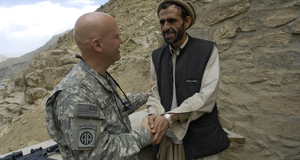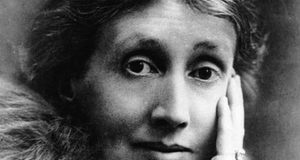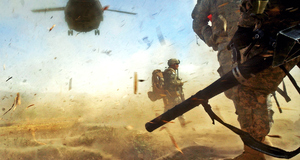Absurdism in Post-Modern Art: Examining the Interplay between "Waiting for Godot" and "Extremely Loud and Incredibly Close"
By
2009, Vol. 1 No. 11 | pg. 2/2 | « Thematically, Foer looks at 9/11 as the spark of a new wave of cultural paranoia, death, destruction, and despair. For Foer’s character, Oskar, the need to search for something brings about a corruption of youthful consciousness as the world gets in the way of his simultaneously precocious and naïve perspective. Oskar’s search is driven by tragedy, and the search itself is what becomes important, is his attempt to make sense of the absurdity of the death of his father and to “affirm the validity of his father’s existence.” Oskar’s character functions as a symbol of the naïve global perspective many Americans had pre-9/11. Foer tries to connect the terrorist attacks to larger truths about human nature. Oskar’s search parallels the ‘wait’ that Vladimir and Estragon undergo in Waiting for Godot. Vladimir and Estragon’s ‘wait’ is a journey of existential action (thought and discussion) while Oskar’s search is interactive with the questions he is trying to answer as well as the people who might lead him to the answers. Oskar goes out into his world actively pursuing answers, Vladimir and Estragon stay within their world actively pursuing answers and neither attains what they thought they were searching for. Contextually, Jonathan Safran Foer’s Everything is Illuminated is representative of the absurdities of life in the post-modern era. The novel begins with a series of seemingly ridiculous and unwarranted hypothetical questions and situations posed by the nine- year old narrator. The book begins with the question: “What about a teakettle?” In this same paragraph Oskar ponders, “Another good thing is that I could train my anus to talk when I farted. If I wanted to be extremely hilarious, I’d train it to say, “Wasn’t me!” every time I made an incredibly bad fart (Foer 1).” While Foer expresses many similar moments of comic ridiculousness he also comments on the more serious absurdity present. September 11th is described through repetition of the same unbelievable, unexplainable images. Their seriousness and horrid nature of the subject matter seems only to be conveyed through repetition. Foer writes:I turned on the television. I lowered the volume until it was silent./ the same pictures over and over./Planes going into buildings./Bodies falling./People waving shirts out of high windows./ Planes going into buildings./Bodies falling./ Planes going into buildings./ People covered in gray dust./Bodies falling./Buildings falling./Planes going into buildings./Planes going into buildings./Buildings falling./ People waving shirts out of high windows./ Bodies fallings./ Planes going into buildings(230). In the novel, September 11th functions as the source of a renewed existential crisis for Americans brought on by the shocking absurdity of the events of the day. In the face of tragedy Foer’s young protagonist questioned his religious beliefs and the significance of his existence. Foer writes, “Even though I’m not one anymore, I used to be an atheist, which means I didn’t believe in things that couldn’t be observed. It’s not that I believe in things that can’t be observed now, because I don’t. It’s that I now believe that things are extremely complicated (Foer 4).” Oskar embraced the ambiguity and absurdity found in his life by constructing an existentialist perspective. He explained his stance as, “I got incredibly heavy boots about how relatively insignificant life is, and how, compared to the universe and compared to time, it didn’t even matter if I existed at all (Foer 86).” Oskar’s assertion that his existence is of no great consequence embodies the absurdist and existentialist idea that life is devoid of purpose and meaning. Foer’s novel concludes with Oskar sticking to this theory of absurdity; Oskar’s journey, like Vladimir and Estragon’s ‘wait,’ produces no results of certainty. What each quest produces is the idea that the only authentic experience possible is the journey, ‘wait,’ or individual action itself. This idea that the meaning attributed to individual action can only be constructed as important in the sense of the individual’s personal interest is an existential ideal which is illustrated through the historical factors and literary works discussed above. Through allusions to and contextualization of the historical factors and events which informed the Absurdist movement as well as the utilization of rhetorical techniques, structures and themes that are characteristic of the movement, Extremely Loud and Incredibly Close exemplifies how Absurdism is carried into the post-modern literary world. . His protagonist, Oskar is a symbol of the result of the process through which post-modern art is defined by the absurdity. The progression from the degradation of morality and the changed conception of ‘God’ that was realized through WWII, fascism, and the Holocaust inherently influenced the ideas of existentialism and future theorists. This progression was realized in Waiting for Godot which as an ultimate example of ‘Theater of the Absurd’ contextualized the culmination of these historical factors and influences to say that life is inherently meaningless and that this absence of meaning is defined by absurdity. ReferencesWWII Timeline 1917-45. University of San Diego History Department. 25 September, 2002. 20 November, 2008. http://history.sandiego.edu/gen/ww2Timeline/1917-45.html “The Nuremberg Race Laws.” The United States Holocaust Memorial Museum. http://www.ushmm.org/outreach/nlaw.htm Appignanesi, Richard, and Oscar Zarate. Introducing Existentialism. New York: Totem Books, 2006. Bair, D. Samuel Beckett: A Biography. London: Vintage, 1990. Bird, Kai and Sherwin, Martin J. "The Myths of Hiroshima." Los Angeles Times. 5 Aug 2005. Esslin, Martin. The Theatre of The Absurd. Garden City, NY: Anchor Books, 1961. Foer, Jonathan Safran. Extremely Loud and Incredibly Close. Boston: Houghton Mifflin Company Trade & Reference Division, 2005. Terry, Joseph. The Longman Anthology of Modern and Contemporary Drama : A Global Perspective. New York: Addison-Wesley Longman, Limited, 2003. Jacobson, Josephine, and William R. Mueller. The Testament of Samuel Beckett. New York, NY: Hill and Wang, 1964. Hall, Peter. Production History. The Guardian, 4 January 2003. http://samuel-beckett.net/Penelope/production_history.html Works ConsultedThe Statistics of War. The History Place. 20 November, 2008 Acheson, James. Samuel Beckett\'s Artistic Theory and Practice : Criticism, Early Fiction and Drama. New York: Palgrave Macmillan Limited, 1996. Begam, Richard. Samuel Beckett and the End of Modernity. Stanford, CA: Standford UP, 1996. Graver, Lawrence, and Raymond Federman, eds. Samuel Beckett. New York: Routledge & Kegan Paul, Limited, 1979. Kalb, J., Beckett In Performance. Cambridge: Cambridge University Press, 1989. McMillan, Dougald, and Martha Fehsenfeld. Beckett in the Theatre : The Author As Practical Playwright and Director. Minneapolis: Calder Publications Limited, 1988. Suggested Reading from Inquiries Journal
Inquiries Journal provides undergraduate and graduate students around the world a platform for the wide dissemination of academic work over a range of core disciplines. Representing the work of students from hundreds of institutions around the globe, Inquiries Journal's large database of academic articles is completely free. Learn more | Blog | Submit Latest in Literature |
















